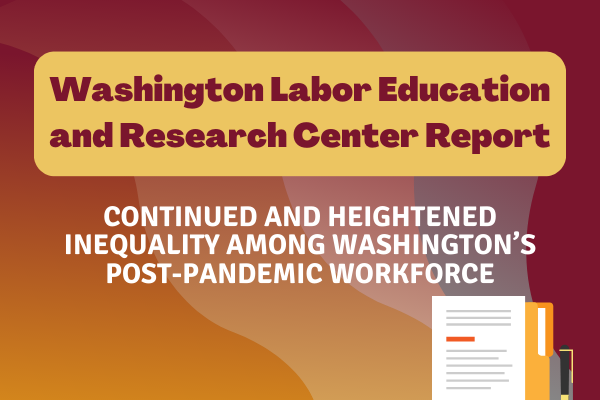Labor Education and
Research Center
We provide education, training, events, and applied research to
working people in Washington State.
Research
The Washington State Labor Education and Research Center conducts high-quality, timely research on labor, employment issues and economic challenges relevant to working families in Washington State.
The Labor Center’s research agenda includes low-wage work, employment standards and work issues affecting workers of color, immigrants and women workers.
The Labor Center collaborates with other Labor Centers across the country, and with researchers at the University of Washington and other institutions. The Labor Center’s research is distributed to stakeholders, media and policy-makers across Washington State.
Continued and Heightened Inequality Among Washington’s Post-Pandemic Workforce
Muhammad Javid and David West, Washington State Labor Education and Research Center
Michael Mulcahy, Working Title Research
February, 2023
While overall employment has returned to pre-pandemic levels, and the unemployment rate has returned to historic lows, the pandemic is not over for our communities. Our analysis of summer 2022 employment data indicates that the pandemic built upon and exacerbated existing inequalities within the workforce.
- Women’s Workforce Participation Down— Historically, women’s participation in the workforce has been lower than that of men. The pandemic continues to exacerbate this pattern.
- Black Women Lead the Return to Work in Washington — The participation rate of Black workers in the workforce is now close to pre-pandemic levels at 67%.
- Mass Departure of Immigrant Women from Workforce Continues — Among all citizenship statuses, non-citizen men have the highest likelihood of being in the workforce at 89%, the same rate as before the pandemic. Non-citizen women have the lowest likelihood of being in the workforce at 53%, compared to native-born and naturalized citizens in 2022.
- Mothers With Small Children Still Out of Workforce — Parents of small children and adults without children have a similar likelihood of being in the workforce overall. We found a stark difference between male and female parents of small children.
We find that to attract workers back into the workforce, businesses and policymakers must use an equitable recovery approach that considers the pandemic’s impacts on all of Washington’s workers, addressing the many ways the pandemic has heightened existing inequities.
View Continued and Heightened Inequality Among Washington’s Post-Pandemic Workforce.
Washington Workers in the Pandemic
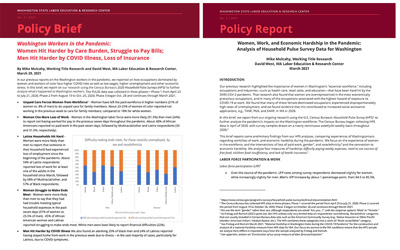
Michael Mulcahy, Working Title Research
David West, Washington State Labor Education and Research Center
March, 2021
Washington Workers in the Pandemic confirms the lived experience of our state’s workers: this pandemic has on average hit women differently from men, white workers differently from Black and Latinx workers. The report, third in a series by the WA Labor Education and Research Center and Working Title Research, confirms:
- The #1 reason women of color have left the workforce: to fulfill unpaid family care needs, rather than for lack of work.
- Men, and particularly Latinx men, were alarmingly and disproportionately likely to have lost work due to illness and COVID19.
- Women, especially women of color, more frequently cited examples of extreme family economic distress – unpaid bills, food insecurity, and children’s food insufficiency. Food insecurity hit families of color, and especially Latinx households, hardest.
Unlike our prior reports focusing on low-wage frontline workers, this report examined households across the state using three different Census Department survey “snapshots”; it compares all workers’ experience across occupations, demographics, and time. This broader look at Washington households confirms: there will be no broad-based recovery until Washington address the childcare crisis and other equity-focused policies to support working families.
View Washington Workers in the Pandemic Policy Brief. View Washington Workers in the Pandemic Full Report.
Highest Risk, Hardest Hit:
Pandemic Impact on Washington’s High-Risk, Low Wage Workers
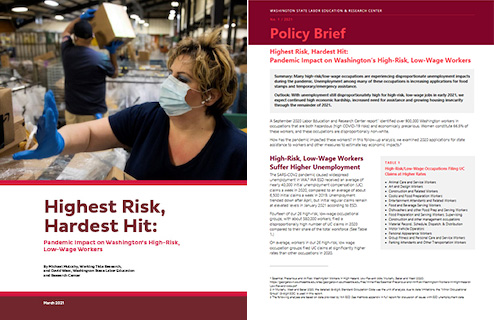
Michael Mulcahy, Working Title Research
David West, Washington State Labor Education and Research Center
March, 2021
Many high-hazard/low-reward occupations are experiencing disproportionate unemployment impacts during the pandemic. Unemployment among many of these occupations is increasing applications for food stamps and temporary/emergency assistance. With unemployment still disproportionately high for high-hazard, low reward jobs in early 2021, we expect continued high economic hardship, increased need for assistance and growing housing insecurity through the remainder of 2021. This report examines applications for state assistance to workers and other measures to estimate key economic impacts on these occupations.
View the Highest Risk, Hardest Hit Policy Brief Summary. View the Highest Risk, Hardest Hit Full report.
The Gender Divide in the Tech Sector

Kimberly Earles
Ph.DOctober 8, 2020
Large tech company gender discrimination stubbornly endures—even during the current pandemic, reveals Gender Divide in Tech, a 2020 study conducted by the Washington Labor Education and Research Center. Researcher Kimberly Earles shows how gender discrimination in the tech sector remains a persistent and even rising regional and national concern, bringing new evidence as well as a framework for changing the tech industry’s culture and working environment to increase gender equality. The report combines recent academic research, media reports, and new qualitative research on the experiences of workers in Seattle’s tech industry. Dozens of women and non-binary tech workers were interviewed at Seattle’s four major tech companies—Amazon, Microsoft, Google, and Facebook. Their experiences, imbued by years of research in the tech sector, graphically reveals the obstacles they and their colleagues continue to face as they seek to thrive and advance in this growing workforce.
View The Gender Divide in the Tech Sector
Essential, Precarious, and At Risk: Washington Workers in High Hazard/Low-Reward Jobs
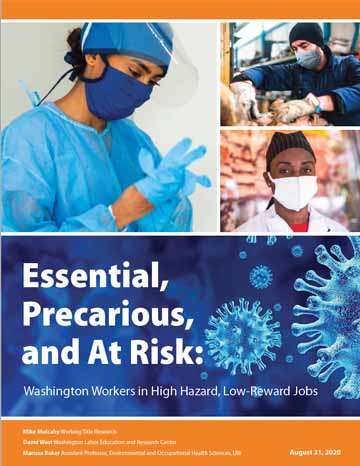
Mike Mulcahy
Working Title ResearchDavid West
Washington State Labor Education and Research CenterMarissa Baker
Assistant Professor, Environmental and Occupational Health Sciences, UWSeptember 1, 2020
Essential, Precarious, and At Risk: Washington Workers in High Hazard/Low-Reward Jobs is the first comprehensive analysis of Washington workers by both economic status and potential SARS-CoV-2 workplace hazards. This research project developed a new research model to study both the economic status and COVID hazards facing essential workers. The study results demonstrate that the COVID risk problem is larger than just the “essential” workforce. The study identified 55 occupations with over 900,000 workers that are both hazardous and economically precarious – occupations that combine low wages or inadequate benefits with high SARS-CoV-2 hazard scores.
View Essential, Precarious, and At Risk: Washington Workers in High Hazard/Low-Reward Jobs
The Union Effect
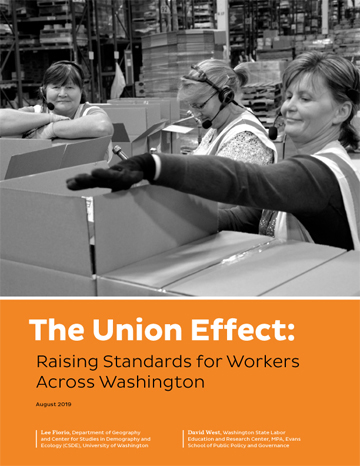
Lee Fiorio
University of WashingtonDavid West
Washington State Labor Education and Research CenterAugust 29, 2019
The Union Effect provides the first study of the economic impact of unions on Washington workers. The report’s findings are consistent with other national and state-level research, demonstrating that Washington unions produce higher wages, better health and pension benefits, reduced racial and gender inequalities, and less use of public assistance programs.
View the Union Effect: Raising Standards for Workers Across Washington
